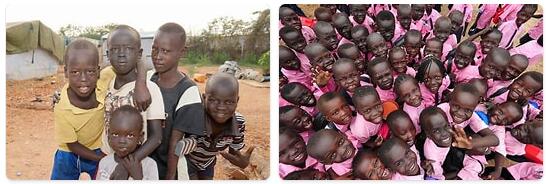Release Game
South Sudan participated in the Sudanese struggle for independence from British colonial rule, which was just as largely driven in the north. A new Anglo-Egyptian agreement in 1953 gave Sudan internal autonomy for three years. The first elections were held in 1953, and representatives from South Sudan joined the new government formed by Ismail al-Azhari in 1954.
In the south, the Liberal Party got the most support; it advocated a federal state custom with a federal government and separate states in the two regions. However, the election was won by the National Unionist Party (NUP), which advocated not only a united Sudan, but a merger with Egypt, which would have further strengthened the Arabization of Sudan. The dissatisfaction with increasing Arabization and marginalization led to the first military resistance in the south: In August 1955, units from the army stationed in Torit revolted. The rebellion was quickly extinguished after the British flew in about 8,000 soldiers from the north. Some of the rebel soldiers escaped, laying the groundwork for the later resistance battle.
Sudan became an independent republic from January 1, 1956, and South Sudan became an integrated region. In South Sudan, this marked the start of a political struggle for self-government that was only concluded with the attainment of independence in 2011.

The first civil war
In the Sudanese parliament, among other things in constitutional discussions, representatives from the south still promoted a federal solution. Uncertainty about political development was exploited by the military to seize power, first in 1958, later on several occasions. In 1958, the commander-in-chief, General Ibrahim Abboud, took power in a military coup, which also had significance for South Sudan, where Arabic was introduced as an educational language and Islam promoted – to promote Sudanese unity, at the expense of South Sudanese identity.
Bureaucrats from the north were placed in central administrative positions, and Christian missionaries, who had been central to providing education in the region, were expelled from 1962. The liberation struggle was fueled by this development, which resulted in a strike in the schools and demonstrations in the south in 1962; schoolchildren fled the country. In 1963, the armed resistance struggle started in earnest, to which the Khartoum government responded with increased repression.
The attitude in the south was divided between those who sought full independence and those who wanted self-government within one Sudan. To those seeking independence, the first organized political and military groups in South Sudan, with the Sudan African Closed Districts Union (SACDU), formed in exile in 1962 and a military branch known as Anyanya established in 1963, and which took up the fight for secession. The party changed its name to the Sudan African National Union (SANU) in 1963 and established its own government, the Nile Provisional Government (NPG), which led the liberation struggle. Following divisions in SANU, the Southern Sudan Liberation Movement (SSLM) formed in 1967, led by Joseph Oduho Haworu (1927–1993), who was also the commander-in-chief of Anyanya.
The SSLM participated in the 1971 negotiations, which in February 1972 led to the so-called Addis Ababa Agreement, which ended the first round of civil war in Sudan, liberation war in South Sudan. The Addis Agreement granted South Sudan local autonomy; the three regions gained autonomy as a single region, with a separate assembly in Juba; elections were held in 1973. The ensuing stability enabled efforts for economic and social development in the south. Among other things, Norwegian Church Aid, with public Norwegian support, launched a large-scale development program in South Sudan – which later had to be abandoned when the war broke out again.
Experiences of continued marginalization and resistance from Khartoum, where Islamization of politics and social life continued, led to the resumption of the military struggle in May 1983, through the Sudanese People’s Liberation Movement (SPLM) and the Sudanese People’s Liberation Army (SPLA), both led by Colonel John Garang de Mabior, which remained its leader until its death in 2005. The Islamization of Sudan during the military regime of Gaafar Muhammad Nimeiri, who seized power in a coup in 1969 and experienced discrimination against the south, contributed to sporadic military resistance even before 1983. The exploitation of the South Sudan’s natural resources, including the construction of the Jonglei Canal to improve the utilization of water from the Nile and extraction of oil, contributed to the flare-up again.